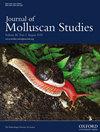Ontogenetic variability in the diel activity pattern of the marine gastropod Cassis cornuta (Mollusca: Cassidae)
IF 1.2
4区 生物学
Q2 MARINE & FRESHWATER BIOLOGY
引用次数: 0
Abstract
Examining activity patterns is essential in understanding gastropod feeding and movement ecology. However, the diel activity patterns of large-bodied gastropods, such as Cassis cornuta, remain poorly studied. Here, we conducted outdoor hatchery-based experiments to examine the diel activity patterns of C. cornuta adults and juveniles under natural sunlight and photoperiod. Activities of C. cornuta, such as crawling, hunting, feeding, burrowing and resting on the substratum, were examined every hour for 3 days. Although most individuals were inactive for a greater part of the observation period, active behaviours were recorded for some individuals during both daytime and nighttime, suggesting that C. cornuta is cathemeral, as supported by a nonsignificant result from a Rayleigh's test of uniformity. A higher proportion of adult and juvenile C. cornuta were inactive, either burrowed or resting on the substratum, during the 24-h period. Peak activity time for juveniles started at 20:00, with up to 50% of individuals active, while peak activity time for adults started at 21:00, with up to 20% of active individuals. Adults spent more time resting aboveground, whereas juveniles spent more time burrowed under the sand when not feeding. Juveniles hunted more frequently and spent more time feeding compared to adults. Additionally, juveniles crawled faster and were more successful in capturing sea urchins than adults. The information on variability in the diel activity patterns and movement rates between adult and juvenile C. cornuta would allow further demographic studies, and provide insights into possible conservation strategies for this species.海洋腹足动物 Cassis cornuta(软体动物门:Cassidae)昼夜活动模式的个体发育变异性
研究活动模式对于了解腹足类动物的摄食和运动生态至关重要。然而,对大型腹足类动物(如粟蟾)昼夜活动模式的研究仍然很少。在此,我们进行了室外孵化实验,以研究在自然日照和光周期条件下玉米须成体和幼体的昼夜活动模式。在连续三天的实验中,我们每隔一小时对玉米螟的爬行、捕食、觅食、穴居和在基质上休息等活动进行了观察。虽然大多数个体在观察期间的大部分时间都不活动,但在白天和夜间都记录到一些个体的活动行为,这表明玉米穗蛙是短暂活动的,雷利均匀性检验的非显著性结果也证明了这一点。在 24 小时内,较高比例的玉米褐飞虱成虫和幼虫不活动,要么钻洞,要么在基质上休息。幼体的活动高峰期始于 20:00,多达 50%的个体处于活动状态,而成体的活动高峰期始于 21:00,多达 20%的个体处于活动状态。成体在地面上休息的时间较长,而幼体在不觅食时则更多地在沙下钻洞。与成体相比,幼体捕食更频繁,觅食时间更长。此外,与成体相比,幼体爬行速度更快,捕获海胆的成功率更高。有关玉米海胆成体和幼体的昼夜活动模式和移动速率差异的信息将有助于进一步的人口统计研究,并为该物种可能的保护策略提供启示。
本文章由计算机程序翻译,如有差异,请以英文原文为准。
求助全文
约1分钟内获得全文
求助全文
来源期刊

Journal of Molluscan Studies
生物-动物学
CiteScore
3.00
自引率
8.30%
发文量
36
审稿时长
3 months
期刊介绍:
The Journal of Molluscan Studies accepts papers on all aspects of the study of molluscs. These include systematics, molecular genetics, palaeontology, ecology, evolution, and physiology. Where the topic is in a specialized field (e.g. parasitology, neurobiology, biochemistry, molecular biology), submissions will still be accepted as long as the mollusc is the principal focus of the study, and not incidental or simply a convenient experimental animal. Papers with a focus on fisheries biology, aquaculture, and control of molluscan pests will be accepted only if they include significant advances in molluscan biology. While systematic papers are encouraged, descriptions of single new taxa will only be considered if they include some ‘added value’, for example in the form of new information on anatomy or distribution, or if they are presented in the context of a systematic revision or phylogenetic analysis of the group.
 求助内容:
求助内容: 应助结果提醒方式:
应助结果提醒方式:


